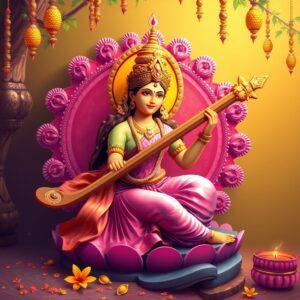Saraswati Puja, also known as Vasant Panchami, is a vibrant Hindu festival honoring Saraswati, the goddess of knowledge, music, art, wisdom, and learning. Celebrated with great enthusiasm across India and beyond, this festival marks the arrival of spring and the pursuit of knowledge.
Delving into the History of Saraswati Puja
The origins of Saraswati Puja can be traced back to ancient Hindu scriptures and mythology. Saraswati is revered as the goddess of wisdom in the Rigveda. Her depiction evolved over time, transforming from a river goddess to the deity of knowledge and arts. She is also mentioned in the Puranas, Mahabharata, and Ramayana. The Gupta period witnessed the formalization of Saraswati worship, with Adi Shankaracharya playing a key role in its widespread adoption across India. Regional variations in celebrating Saraswati Puja exist across India and neighboring countries like Nepal and Indonesia.
The Significance and Symbolism of Saraswati Puja
Saraswati Puja is a celebration of wisdom and learning. Saraswati’s iconography connects her with the swan (purity), lotus (knowledge), veena (music), and books (learning). The festival coincides with the beginning of spring, symbolizing new beginnings and the pursuit of knowledge. Yellow, representing knowledge and learning, is prominent during the festivities. Rituals include placing books and musical instruments near the idol for blessings. ‘Aksharabhyasam’, a ritual introducing young children to the alphabet, is also performed on this day. Students and scholars seek blessings for academic success and intellectual growth.
Rituals and Practices of Saraswati Puja
While varying regionally, Saraswati Puja rituals share common elements of devotion. The idol or image of Saraswati is prepared using materials symbolizing purity and knowledge. ‘Pran Pratishtha’ invokes the goddess into the idol. Offerings of fruits, sweets, and ‘prasad’ hold symbolic meanings. ‘Anjali’, offering flowers and prayers, seeks blessings. ‘Saraswati Vandana’, a devotional hymn, is sung during the puja. Communal events like cultural programs, music, and poetry recitals are also integral parts of the festival. The idol’s immersion in water bodies symbolizes the cycle of creation and dissolution.
Regional Variations and Celebrations
Saraswati Puja is celebrated with unique customs and traditions across various regions, each adding its own cultural flavor.
West Bengal
In West Bengal, Saraswati Puja is a grand occasion with schools and colleges closed. Students actively participate in festivities, adorning the idol with a white saree and placing books and instruments nearby for blessings. ‘Anjali’ and ‘bhog’ distribution are essential parts of the celebration.
Odisha and Bihar
Odisha and Bihar celebrate with fervor, decorating temples and homes. ‘Aksharabhyasam’ is significant for students, marking their educational initiation. Special prayers and cultural programs enhance the festivities.
Assam
Assam’s ‘Shree Panchami’ features traditional music and dance. Community gatherings and temple decorations highlight the celebrations.
South India
In South India, Saraswati Puja is part of Navratri. ‘Ayudha Puja’, worshipping tools and instruments, is common in Tamil Nadu and Karnataka. ‘Kolams’ (rangoli designs) adorn homes.
Nepal
Nepal’s ‘Shree Panchami’ involves temple gatherings and prayers for wisdom and learning. Educational institutions actively participate.
Global Celebrations
The Indian diaspora celebrates Saraswati Puja globally. Traditional rituals and virtual celebrations connect communities worldwide.
Modern-Day Relevance and Adaptations
Saraswati Puja remains significant in the modern world, blending tradition with contemporary elements.
Technology and Virtual Celebrations
Virtual pujas and online streaming facilitate participation for those far from home. Social media connects communities and shares the celebrations.
Eco-Friendly Practices
Biodegradable idols and environmentally conscious practices are gaining popularity.
Educational Institutions
Schools and colleges organize cultural events, fostering cultural heritage and promoting knowledge.
Commercial Aspects
Online platforms offer puja items and traditional attire, blending convenience with tradition. Saraswati Puja Dashakarma Kit, Saraswati Puja Kit for Murti Puja, Fountain Pen Ink for Puja, Cotton Wicks for Diya and more are available on Poojn.in.
How Poojn.in Enhances Your Saraswati Puja
Poojn.in simplifies your Saraswati Puja preparations by offering a wide selection of authentic puja supplies. Find everything you need in one place, including idols, puja thalis, incense, diyas, flowers, decorations, and other essentials. Poojn.in ensures authentic, traditionally significant items delivered to your doorstep, allowing you to focus on the spiritual aspects of the celebration.
Conclusion
Saraswati Puja is a celebration of knowledge, wisdom, and the arts, uniting communities across India and beyond. Each region adds its unique touch, showcasing India’s rich cultural diversity. Adapting to modern times, the festival’s essence remains unchanged, inspiring reverence for education and intellectual growth. The blend of tradition and innovation ensures Saraswati Puja’s continued relevance, bringing joy and unity. Let us cherish this tradition and seek Saraswati’s blessings for a brighter, more knowledgeable future.
FAQs: Understanding Saraswati Puja
What are the origins of Saraswati Puja? Saraswati Puja has roots in ancient Hindu traditions, mentioned in texts like the Rigveda, where Saraswati is revered for wisdom and the arts.
Why do we celebrate Saraswati Puja? We celebrate to honor Goddess Saraswati, seeking her blessings for wisdom, knowledge, and artistic skills.
What is the cultural significance? Saraswati Puja promotes education and the arts, offering a day for students, artists, and scholars to seek guidance.
When is it celebrated? It’s celebrated on Vasant Panchami, the fifth day of the Hindu month of Magha (January/February).
How is the puja performed? An idol or image of Saraswati is set up, offerings are made, and rituals and prayers are performed.
What are the traditional foods? Sweets like kheer and halwa, along with fruits, are offered and shared.
What are the associated symbols? The veena, books, and a swan symbolize music, knowledge, and purity.
Can non-Hindus participate? Yes, the celebration is open to all who value education, the arts, and knowledge.


